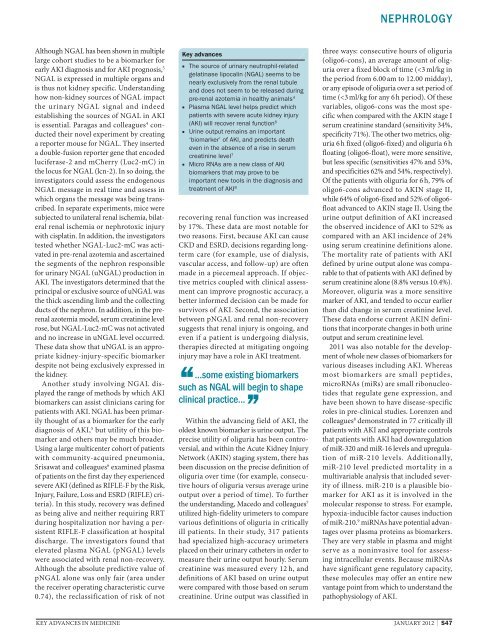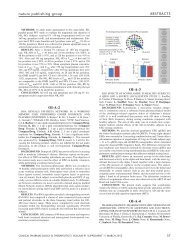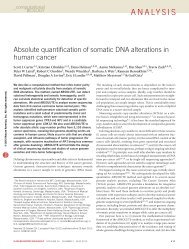open access: Nature Reviews: Key Advances in Medicine
open access: Nature Reviews: Key Advances in Medicine
open access: Nature Reviews: Key Advances in Medicine
You also want an ePaper? Increase the reach of your titles
YUMPU automatically turns print PDFs into web optimized ePapers that Google loves.
Although NGAL has been shown <strong>in</strong> multiple<br />
large cohort studies to be a biomarker for<br />
early AKI diagnosis and for AKI prognosis, 5<br />
NGAL is expressed <strong>in</strong> multi ple organs and<br />
is thus not kidney specific. Understand<strong>in</strong>g<br />
how non-kidney sources of NGAL impact<br />
the ur<strong>in</strong>ary NGAL signal and <strong>in</strong>deed<br />
establish<strong>in</strong>g the sources of NGAL <strong>in</strong> AKI<br />
is essential. Paragas and colleagues 4 conducted<br />
their novel experiment by creat<strong>in</strong>g<br />
a reporter mouse for NGAL. They <strong>in</strong>serted<br />
a double-fusion reporter gene that encoded<br />
luciferase-2 and mCherry (Luc2-mC) <strong>in</strong><br />
the locus for NGAL (lcn-2). In so do<strong>in</strong>g, the<br />
<strong>in</strong>vestigators could assess the endogenous<br />
NGAL message <strong>in</strong> real time and assess <strong>in</strong><br />
which organs the message was be<strong>in</strong>g transcribed.<br />
In separate experiments, mice were<br />
subjected to unilateral renal ischemia, bilateral<br />
renal ischemia or nephrotoxic <strong>in</strong>jury<br />
with cisplat<strong>in</strong>. In addition, the <strong>in</strong>vestigators<br />
tested whether NGAL-Luc2-mC was activated<br />
<strong>in</strong> pre-renal azotemia and ascerta<strong>in</strong>ed<br />
the segments of the nephron responsible<br />
for ur<strong>in</strong>ary NGAL (uNGAL) production <strong>in</strong><br />
AKI. The <strong>in</strong>vesti gators determ<strong>in</strong>ed that the<br />
pr<strong>in</strong>cipal or exclusive source of uNGAL was<br />
the thick ascend<strong>in</strong>g limb and the collect<strong>in</strong>g<br />
ducts of the nephron. In addition, <strong>in</strong> the prerenal<br />
azotemia model, serum creat<strong>in</strong><strong>in</strong>e level<br />
rose, but NGAL-Luc2-mC was not activated<br />
and no <strong>in</strong>crease <strong>in</strong> uNGAL level occurred.<br />
These data show that uNGAL is an appropriate<br />
kidney-<strong>in</strong>jury-specific biomarker<br />
despite not be<strong>in</strong>g exclusively expressed <strong>in</strong><br />
the kidney.<br />
Another study <strong>in</strong>volv<strong>in</strong>g NGAL displayed<br />
the range of methods by which AKI<br />
biomarkers can assist cl<strong>in</strong>icians car<strong>in</strong>g for<br />
patients with AKI. NGAL has been primarily<br />
thought of as a biomarker for the early<br />
diagnosis of AKI, 5 but utility of this biomarker<br />
and others may be much broader.<br />
Us<strong>in</strong>g a large multicenter cohort of patients<br />
with community-acquired pneumonia,<br />
Srisawat and colleagues 6 exam<strong>in</strong>ed plasma<br />
of patients on the first day they experienced<br />
severe AKI (def<strong>in</strong>ed as RIFLE-F by the Risk,<br />
Injury, Failure, Loss and ESRD (RIFLE) criteria).<br />
In this study, recovery was def<strong>in</strong>ed<br />
as be<strong>in</strong>g alive and neither requir<strong>in</strong>g RRT<br />
dur<strong>in</strong>g hospitalization nor hav<strong>in</strong>g a persistent<br />
RIFLE-F classification at hospital<br />
discharge. The <strong>in</strong>vestigators found that<br />
elevated plasma NGAL (pNGAL) levels<br />
were associated with renal non-recovery.<br />
Although the absolute predictive value of<br />
pNGAL alone was only fair (area under<br />
the receiver operat<strong>in</strong>g characteristic curve<br />
0.74), the reclassification of risk of not<br />
<strong>Key</strong> advances<br />
■ The source of ur<strong>in</strong>ary neutrophil-related<br />
gelat<strong>in</strong>ase lipocal<strong>in</strong> (NGAL) seems to be<br />
nearly exclusively from the renal tubule<br />
and does not seem to be released dur<strong>in</strong>g<br />
pre-renal azotemia <strong>in</strong> healthy animals 4<br />
■ Plasma NGAL level helps predict which<br />
patients with severe acute kidney <strong>in</strong>jury<br />
(AKI) will recover renal function 6<br />
■ Ur<strong>in</strong>e output rema<strong>in</strong>s an important<br />
‘biomarker’ of AKI, and predicts death<br />
even <strong>in</strong> the absence of a rise <strong>in</strong> serum<br />
creat<strong>in</strong><strong>in</strong>e level 7<br />
■ Micro RNAs are a new class of AKI<br />
biomarkers that may prove to be<br />
important new tools <strong>in</strong> the diagnosis and<br />
treatment of AKI 8<br />
recover<strong>in</strong>g renal function was <strong>in</strong>creased<br />
by 17%. These data are most notable for<br />
two reasons. First, because AKI can cause<br />
CKD and ESRD, decisions regard<strong>in</strong>g longterm<br />
care (for example, use of dialysis,<br />
vascular <strong>access</strong>, and follow-up) are often<br />
made <strong>in</strong> a piecemeal approach. If objective<br />
metrics coupled with cl<strong>in</strong>ical assessment<br />
can improve prognostic accuracy, a<br />
better <strong>in</strong>formed decision can be made for<br />
survivors of AKI. Second, the association<br />
between pNGAL and renal non-recovery<br />
suggests that renal <strong>in</strong>jury is ongo<strong>in</strong>g, and<br />
even if a patient is under go<strong>in</strong>g dialysis,<br />
thera pies directed at mitiga t<strong>in</strong>g ongo<strong>in</strong>g<br />
<strong>in</strong>jury may have a role <strong>in</strong> AKI treatment.<br />
‘‘ ...some exist<strong>in</strong>g biomarkers<br />
such as NGAL will beg<strong>in</strong> to shape<br />
cl<strong>in</strong>ical practice...<br />
With<strong>in</strong> the advanc<strong>in</strong>g field of AKI, the<br />
oldest known biomarker is ur<strong>in</strong>e output. The<br />
precise utility of oliguria has been controversial,<br />
and with<strong>in</strong> the Acute Kidney Injury<br />
Network (AKIN) stag<strong>in</strong>g system, there has<br />
been discussion on the precise def<strong>in</strong>ition of<br />
oliguria over time (for example, consecutive<br />
hours of oliguria versus average ur<strong>in</strong>e<br />
output over a period of time). To further<br />
the understand<strong>in</strong>g, Macedo and colleagues7 ’’<br />
utilized high-fidelity urimeters to compare<br />
various def<strong>in</strong>itions of oliguria <strong>in</strong> critically<br />
ill patients. In their study, 317 patients<br />
had speciali zed high-accuracy urimeters<br />
placed on their ur<strong>in</strong>ary catheters <strong>in</strong> order to<br />
measure their ur<strong>in</strong>e output hourly. Serum<br />
creat<strong>in</strong><strong>in</strong>e was measured every 12 h, and<br />
def<strong>in</strong>itions of AKI based on ur<strong>in</strong>e output<br />
were compared with those based on serum<br />
creat<strong>in</strong><strong>in</strong>e. Ur<strong>in</strong>e output was classified <strong>in</strong><br />
NEPHROLOGY<br />
three ways: consecutive hours of oliguria<br />
(oligo6-cons), an average amount of oliguria<br />
over a fixed block of time (








